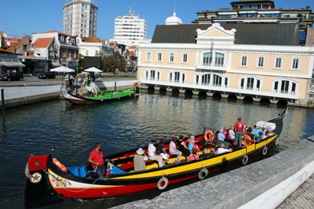
Click the photo above to see a album of our visit to Aveiro. Close the window to return to this page.
 Click the photo above to see a album of our visit to Aveiro. Close the window to return to this page. |
|
Read previous Porto Portugal or read next Nazare and Obidos
September 29 to October 1 2019
No, we are not in Venice, Italy in a gondola. We are in Aveiro, the "Venice of Portugal" in a boat, a barco moliciero, once used by fishermen to collect seaweed as fertilizer for their gardens. Our guide, a charming young lady from Columbia, South America, is telling us all about Aveiro, a small city set on an Atlantic coast lagoon, Ria de Aveira. We are navigating through several canals learning that Alveiro was a center of salt and trade by the Romans long ago plus enjoying the varied architectural styles of the canal-side houses. It is still an industrial city and an important port, but tourism is increasingly important. Gondola-style boat after boat pass us as we make our way through the five canals between the town and the sea.
It was only
about an hour from Porto to Alveiro, the perfect place to take a break from our
trip from Porto to Coimbra. We enjoyed a good lunch, walked some of the streets
and of course, the boat ride was the perfect way to get the true flavour of the
city. It was later in the afternoon by the time we continued on to Coimbra.
I recognize those fellows. They are wearing the
traditional black cloaks, called "Traje" attesting to the fact they are students
at a Portuguese University. In Porto, they are nicknamed "bats" for their
cloaks. After a first year student participates in a "Praxe", an initiation
ceremony, they are permitted to wear the full formal outfit, consisting of the
famous black, wool cloak, a black jacket, white shirt, black tie, black pants
for men and black skirts for women. The cloaks were an inspiration for the gowns
worn by J. K. Rowlings Harry Potter students, but they are also similar, but in
a lighter fabric than wool, to the gowns we wore to class at Bishop's University
in the 1960s.
We arrived
in Coimbra the previous evening, staying at the conveniently located Stay Hotel.
Coimbra is home of the oldest university in Portugal, founded in 1290, so a
visit to Coimbra University, situated at the top of a hill was a must. We took a
taxi up the hill to the University and bought tickets to visit the famous
library. The University is an impressive compound in a formed Royal Palace, in
use when Coimbra was the capital city of Portugal. It was an interesting visit.
We took in the Grand Hall, where students attend formal ceremonies, such as
graduation or defending a thesis, all outfitted in the full traditional outfit.
Down the corridor from the grand hall was access to a narrow observation
platform stretching around two sides of the roof with a great view of the city.
We made sure we were at the door to King Joćo's
Library at our appointed time, as late arrivals were not permitted entry. The
library, reminiscent of the Spanish libraries in Mexico, holds 40,000 volumes
and is one of the best surviving 18th C Baroque style libraries in Europe.
We walked back to the top of a funicular that took us
right to the center of the old town. We took in some of the the sights along the
way and ended at the Church of Santa Cruz, next door to Cafe Santa Cruz. The
Cafe, originally a church, was de-consecrated in the 1830s when monasteries and
other religious buildings were taken over by the government. Every evening at 6
PM the Cafe is host to a free Fado performance, performed in the space occupied
by the altar. We made a reservation to attend that evening and were glad we did.
We ordered a carafe of Sangria and sat back to enjoy the Fado ballads performed
by an older gentleman who organizes the events. He was accompanied by a
classical guitarist and a traditional Portuguese guitarist, both very
accomplished. The performance made up for the disappointment of our Porto
experience.
After the Fado performance, we were ready for a good
dinner at the Restaurante Solar de Bacalhua. Cod is their specialty and it was
very good, ending an enjoyable stay in Coimbra.
Return to Portugal Intro for the rest of our trip
Return to Europe
Return to Travels
Return to Introduction